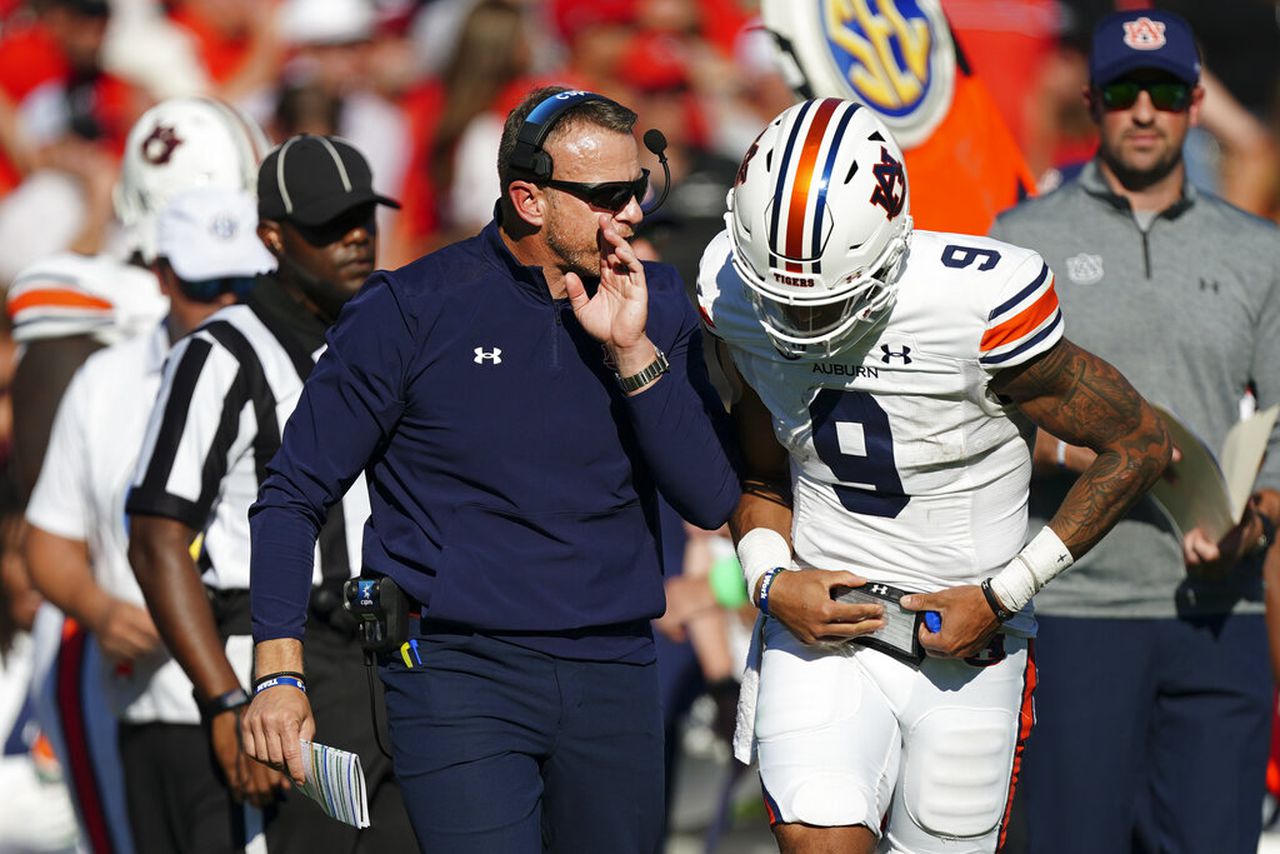The pressing issue Auburn’s offense must resolve against No. 9 Ole Miss
Auburn’s offense was left searching for more answers after its meandering performance last weekend against Georgia, and one of the most pressing issues the unit needs to resolve entering Week 7 — with a trip to Ole Miss on the itinerary — is finding a way to sustain drives.
The Tigers have struggled to do that in SEC play, and it was particularly notable during the team’s 42-10 loss to rival Georgia last weekend.
“You want to keep the ball in your offense’s hands,” Auburn coach Bryan Harsin said. “I think that’s one of the things that hurt our defense (against Georgia).”
Read more Auburn football: Bryan Harsin left searching for answers, “hope” after blowout loss to Georgia
Bryan Harsin justifies failed fake punt attempt against Georgia
Statistically speaking: Auburn’s defense folding in the red zone
Auburn had 14 possessions during its loss to Georgia, with nine of those drives ending in punts, including six three-and-outs. The Tigers had just one drive longer than 39 yards — the fourth-quarter drive in which Jarquez Hunter scored a 62-yard touchdown — and only one possession that exceeded 4 minutes (that one ended in a punt after eight plays), as the Bulldogs dominated time of possession between the hedges, particularly in the second half, when they controlled the clock for twice as long as Auburn did.
Auburn simply was unable to keep its offense on the field for sustained periods of time against Georgia. Its longest drive of the day was the aforementioned eight-play possession, which covered just 28 yards and resulted in Oscar Chapman’s sixth punt of the afternoon. The offense struggled to find success in the run game, and its passing game was sporadic, with Robby Ashford completing just 13-of-38 passes.
Of course, the Tigers did themselves no favors, committing 10 penalties on the day, with seven of them coming on offense and impacting drives while putting themselves behind the chains. Of the seven drives on which the offense committed a penalty, Auburn punted on five of them. Another ended after a failed fake punt attempt, while the other — the Tigers’ most promising drive of the first half — ended in a fumble.
In all, Auburn’s average distance to gain on third downs against Georgia was 8.1 yards. The Tigers converted just five of their 17 third-down attempts for the game.
“That’s the consistency piece of execution, over and over, giving our guys the best chance by our play-calls to keep ourselves on the field, put ourselves in manageable situations,” Harsin said. “The penalties, we need to eliminate those, because that creates a more difficult situation, just down-and-distance.”
Having those problems moving the ball against Georgia, the nation’s top-ranked team and the defending national champion, is one thing. It’s another thing for those issues to recur week in and week out, as has been the case for Auburn in SEC play this season.
Auburn had early success on offense against both Missouri and LSU, but outside of those early touchdowns, Harsin’s offense struggled to sustain drives in both of those games.
In the SEC opener against Missouri, Auburn had 12 possessions in regulation, punting on eight of them, with four of them resulting in three-and-outs. There was also a turnover on downs that capped a five-play drive and a missed field goal at the end of a four-play possession. Half of Auburn’s possessions in regulation gained fewer than 10 yards, with two of them actually losing yardage. Outside of the opening drive, when Auburn scored a touchdown after 14 consecutive rushing attempts, the offense had just two possessions that exceeded 4 minutes.
Auburn’s average distance to gain on third downs against Missouri was 9.4 yards.
The following week against LSU, Auburn had 13 possessions. Four of them ended in punts, with three three-and-outs. Auburn had two drives that lasted longer than 3 minutes; one ended in an interception, the other in a missed field goal. The team’s average starting field position was its own 28-yard line. Auburn averaged 8.4 yards to go on third downs.
“Sustaining drives is huge,” Harsin said. “Creating field position is huge, and then ultimately those drives turning into points, and that’s got to be something we do a much better job of.”
That will certainly be true this weekend, when Auburn (3-3, 1-2 SEC) travels to Oxford, Miss., to take on No. 9 Ole Miss (6-0, 2-0). The Rebels have one of the nation’s top scoring offenses, averaging 39.7 points per game (17th nationally, third in the SEC)—despite touting the lowest time of possession among all FBS teams.
In other words: Ole Miss scores often, and it scores in a hurry.
The longer Auburn’s offense can stay on the field, and certainly the more points it can put up after sustained drives, the more time the Tigers’ defense will have to regroup — and, of course, keep Ole Miss’ offense on the sideline.
“We want to sustain drives, stay on the field and really balance out the time of possession,” Harsin said. “The one thing for Ole Miss, they go fast. They’re not going to talk about time of possession, and that’s not always the key factor in the game. But for us, it’s just about execution, it’s about staying on the field and putting the ball in a position where we can sustain those drives, execute those third downs, create field position and ultimately get in the red zone and find ways to score.”
Tom Green is an Auburn beat reporter for Alabama Media Group. Follow him on Twitter @Tomas_Verde.
